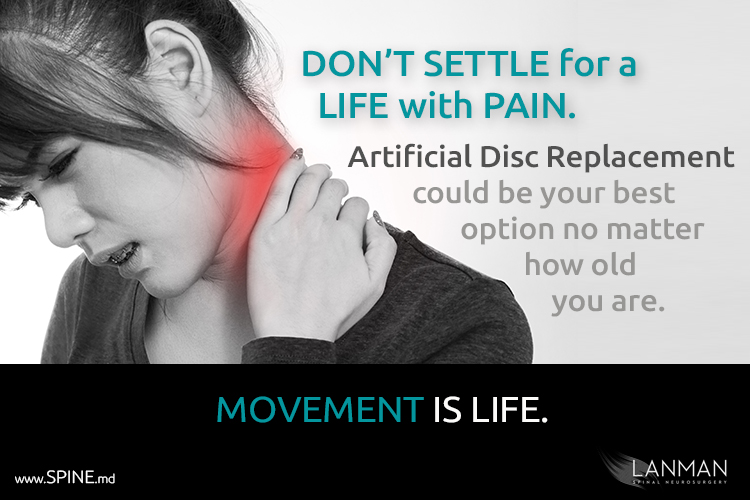Artificial Disc Replacement can help us reach for the highest quality life possible – no matter how old we are.
As we age, we develop pain. It’s a natural process of aging, but also life. Add the fact that we are living longer (much longer than our parent’s generation) only increases the likelihood that we will develop chronic neck and back pain.
That doesn’t necessarily mean that we can’t do anything about it. We can. Every day, I meet patients at my spinal neurosurgical practice in Beverly Hills and in my capacity as an attending neurosurgeon at Cedar-Sinai Medical Center in Los Angeles who have arrived at that time in their life. What they want is to prosper with the highest quality of life that they can attain. What that means for most patients is to live a life free of pain and with as much freedom of movement as possible.
Where neck and back pain are concerned, often it is a failure of a disc – herniation of the disc itself – that causes the pain. The herniated disc itself or a bone spur may put pressure on a nearby nerve. If this is the case, then some form of surgery is often involved. If your condition allows, I may recommend microdiscectomy (microdecompression) to remove disc material to relieve pressure on the nerve. The advantage of this micro surgical procedure is that it changes almost nothing of the mechanical structure of the spine; joints, ligaments, and muscle are barely touched. My patients come into the office and go home the same day with less pain.
For more severe conditions, I may recommend artificial disc replacement. By replacing the disc with an artificial one, I can help a patient retain all the natural movement they had when their disc was healthy. This procedure is new compared to spinal fusion, which has dominated American and European surgical treatment methodology for nearly 100 years. I consider fusion the “brute force” against back and neck pain. Instead of treating the cause of the pain (e.g., herniated disc), fusion immobilizes the flexible joint level between two vertebrae. The patient is faced with two problems: immediate degradation of movement and the very high likelihood that new back problems (and new pain) due to increased stress on adjacent vertebrae.
Artificial disc replacement (ADR) has been around long enough to develop a strong track record. The most important outcome of recent clinical studies is the revelation that patients who underwent artificial disc replacement had significantly better outcomes than patients with spinal fusion. Significant statistical data shows that ADR patients preserved natural movement and they experienced fewer complications, thus requiring fewer corrective surgeries.
However, on occasion, ADR patients need a little extra help.
About two years ago, one of my earliest ADR patients came back to me with new complaints of cervical (neck) pain. She had an artificial disc that I placed ten years ago and was developing another disc failure at another level. I recommended a second ADR procedure, and she went home with no pain and full natural mobility. Then recently she came back again with new pain from the same region, plus the accompanying numbness in the arms and persistent shoulder ache.
Fortunately for her, her other untreated discs appeared normal on MRI. Then a subsequent CAT scan revealed that the original artificial disc I placed was developing a small bone spur that was irritating the nerve. I presented options: I could remove the old disc and fuse the levels or replace the old disc with a new model that had performed very well in recent clinical studies. She told me that she did not want a fusion under any circumstance because she wanted to maintain her full natural mobility. That surgery was very successful, and I am happy to report that once again, her shoulder and arm pain have disappeared and she is back working full time with her full range of neck motion preserved.
Revision surgeries for fusion patients occur more frequently, but even some patients who have had disc replacements may need revision from time to time. In the case of fusion, clinical studies show that there is an increased likelihood of an additional failure of adjacent discs. In the case of disc replacement, the devices do not fail, but surrounding bone can develop spurs the same way they do with normal disks.
Artificial discs were first introduced in the U.S. in 2000. But the artificial disc devices themselves are designed to last 70 years. Technically speaking, discs do not need to be revised. We cannot control the way the body naturally works. Bone spurs and other complications can develop, and pain can return. Knee replacement surgery often needs revision within 15 years of the original surgery; hip replacement is often revised after 25 years. Compared with other surgical procedures, artificial disc replacement is as close to perfection as is humanly possible with the current level of technology.
Along with living longer comes new challenges. Pain may be inevitable, but you don’t have to settle for a life with pain. Modern medical technology is constantly producing new ways to solve old problems. That’s why I continue my work on artificial discs and to help advance surgical methodology. That’s why, in my practice, my goal is not just to solve the pain, but to be greater than better.
###







